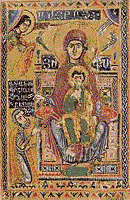
The history of Armenia adds up to over 3 millennia, dating back to the history of Urartu(the Araratyan kingdom), a powerful state, a peer and rival of Assyria. Following the decline of Urartu by the end of the 7th century B.C. the ancient kingdom emerged on its ruins, ruled by the kings of the Yervanduni dynasty. Shortly thereafter the Armenian kingdom fell under the domination of the Persian state of Achaeminids.
By the end of the 4th century B.C the situation in Asia Minor had changed radically: the troops of Alexander the Great have invaded from the West and crushed the Achaeminid kingdom and as a result the colossal empire of Alexander the Great emerged.
Armenia broke into two parts: The Greater Armenia (comprising most of the Armenian plateau) and Lesser Armenia (the territory of upper Euphrates).Lesser Armenia became a part of Alexander''s empire, while Greater Armenia restored its independence and descendants of Yervandouni continued to reign there. Following the collapse of the empire of Alexander the Great Armenia was included in the State of the Seleucids. Hellenism had a great impact on the socio-economic and cultural life of the Armenian society.
In the beginning of the 2nd century B.C. a united Armenian kingdom came into being. The king of Greater Armenia Artashes I, the founder of the Artashesid dynasty, converged into a united state most of the Armenian populated lands of the Armenian plateau. The state of the Artashesid reached the peak of its might during the reign of Tigran the Great II. Armenia substantially expanded its boundaries. Rome took over and forced a peace treaty. The dynasty phased out in the 1st century B.C.
Trdat I became the founder of the Arshakunid dynasty in the 1st century A.D. Important events took place while the dynasty was in power. The country embarked on the period of development of feudal relations, it adopted Christianity in 301A.D as a state religion and in 405 A.D the Armenian script was created by the scholar Mesrop Mashtots.
In 428 having lost its sovereignty, Armenia became a part of Sasanid Iran, but it preserved certain institutes of self-governance as well as the social status of landowners. But towards the end of the 5th century the situation changed. Iran increased the taxes and urged to convert Armenians to Mazdeism, a branch of Zorostrianism professed in Iran. A popular uprising was the response. On May 26, 451 the decisive battle was waged on the Avarayr plain which was conducted by sparapet Vardan Mamikonyan. According to an eye-witness historian Yeghishe there were neither winners, nor losers in this battle.
The 7th century was marked by new changes in the political situation of Asia Minor as result of Arab conquests. In 610 the Arabs entered Eastern Armenia for the first time and established their rule there.
But in the 9th century Bagratunis managed to strengthen its position and proclaimed the independence of Greater Armenia. Ashot I became the 1st king of the new dynasty. Having existed for 160 years, the state of Bagratunis left a visible trace in the history of the Armenian people. In 1045 the state was taken by Byzantians and the last Bagratuni king Gagik II was dethroned and escorted to Byzantium.
The next several centuries added up to one of the most dire periods of Armenia. From the second half of the 12th century Armenia succumbed to devastating raids of successive foreign conquerors: The Seljuk tribes, the Mongols, the hordes of Tamerlane.All these conquerors were at a lower stage of socio-economic and cultural development compared to Armenia, for which reason Armenia suffered serious setbacks and degradation. The state of Ottoman Turks emerged in the middle of the 14th century. They conquered Konstantinople and the Byzantine empire ceased to exist. Armenia became a battlefield between Turkey and Iran. In 1636 they concluded a peace treaty. Western Armenia was ceded to Turkey, while Eastern Armenia went to Iran.
But in the 11th century Cilician Armenian state came into being and lasted for 300 years it was a nation-state away from its homeland. The founder was Prince Rouben. The Cilician Armenian state reached its prime by the end of the 12th century during the reign of Levon II, who was proclaimed king and recognized not only by a number of European courts, but by Byzantium itself. In 1375 the kingdom ceased to exist.
The 17th and 18th centuries were marked by search of ways for liberation from the yoke of Turkey and Iran.
In the 19th century in the course of the Russo-Persian war the Russian troops took over and according to Turkmenchai treaty of 1828, Iran accepted the transfer of Eastern Armenia into Russia.
In the 2nd half of the 19th century the situation of Western Armenians under the rule of the Ottoman empire continued to deteriorate. In 1894 - 1896 the Turkish authorities organized a large-scale slaughter of Armenians in Western Armenia and in other Armenian-populated areas of Turkey. The slaughter was marked by extreme cruelty. In 1915 taking advantage of the outbreak of war, the Turkish authorities set out to implement the long-planned program of the extermination of the Armenian population of Turkey. On April 24 they arrested more then 800 intellectuals and deported them to the sticks of Anatolia. Many of them were killed along the way. The total number of victims reaches 1.5 million people, approximately 800 000 Armenians became exiles and dispersed over the world. In 1918 Armenia proclaimed its independence. It lasted for two years. In 1920 Armenia was proclaimed a Soviet Republic. In the 7 decades that followed Armenia remained within the USSR. Throughout this period Armenia followed a knotty course of socio-economic and political development, marked by accomplishments and deprivation, success and sacrifices.
In 1991 after the Karabakh movement Armenia became independent and was renamed the Republic of Armenia.
www.armstudents.narod.ru
armstudents@yahoo.com
|

